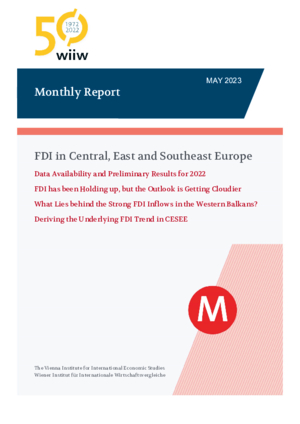Monthly Report No. 5/2023 - FDI in Central, East and Southeast Europe
Alexandra Bykova, Branimir Jovanović, Olga Pindyuk and Nina Vujanović
wiiw Monthly Report No. 5, May 2023
50 pages 46 pages including 23 Tables and 19 Figures
This issue of the wiiw Monthly Report replaces our earlier series of the wiiw FDI Report.
FDI in Central, East and Southeast Europe
- Data availability and preliminary results for 2022
by Alexandra Bykova
FDI inflows into CESEE countries, excluding Russia, grew by 10.8% last year. Performance was highly uneven across the countries of the region. Russia’s isolation due to its war in Ukraine led to large-scale disinvestment of EUR 40bn, according to preliminary estimates. Preliminary FDI data for 2022 are available from the wiiw FDI Database as a first FDI data release this year. Data revisions and FDI data by partner and by economic activity will be released later, in autumn.
- FDI has been holding up, but the outlook is getting cloudier
by Olga Pindyuk
In contrast to the global trends, FDI inflows in CESEE increased in 2022, apart from in Russia and Ukraine. However, recent trends in greenfield investment and mergers and acquisitions signal a worsening of investment prospects. Southeast Europe is emerging as the most dynamic sub-region in terms of FDI attraction. Spurred by digitalisation and green transition developments, investors in the region have become increasingly interested in the renewable energy and electronic components sectors.
- What lies behind the strong FDI inflows in the Western Balkans?
by Branimir Jovanović
The six Western Balkan economies stood out as top performers in terms of FDI inflows within the Central, East and Southeast Europe region in 2022. However, a closer examination reveals a more nuanced picture regarding the composition and characteristics of investments, prompting questions about the overall advantages and long-term sustainability of the inflows. Although the region is projected to continue to attract substantial FDI in the near future, it is likely that the pace will decelerate from the remarkable performance witnessed in 2022.
- Deriving the underlying FDI trend in CESEE
by Nina Vujanović
FDI has been pivotal for the growth of CESEE economies. However, the patterns of FDI flows have been highly volatile. To allow policy makers to draw sound conclusions, we derive the underlying FDI trend for the CESEE region. The results show that, although the trend has consistently been upward since 1997, shocks caused by the global financial crisis, COVID-19 and the war in Ukraine have had a strong impact.
- Forecasts of main economic indicators for Central, East and Southeast Europe for 2023-2025
Reference to wiiw databases: wiiw Annual Database, wiiw Monthly Database, wiiw FDI Database
Keywords: FDI inflows, FDI outflows, FDI stocks, FDI by instrument of financing, greenfield investment, M&As, FDI by components, FDI by partner, FDI by sector, underlying FDI trend, intra-company loans
Countries covered: CESEE, Western Balkans
Research Areas: International Trade, Competitiveness and FDI
